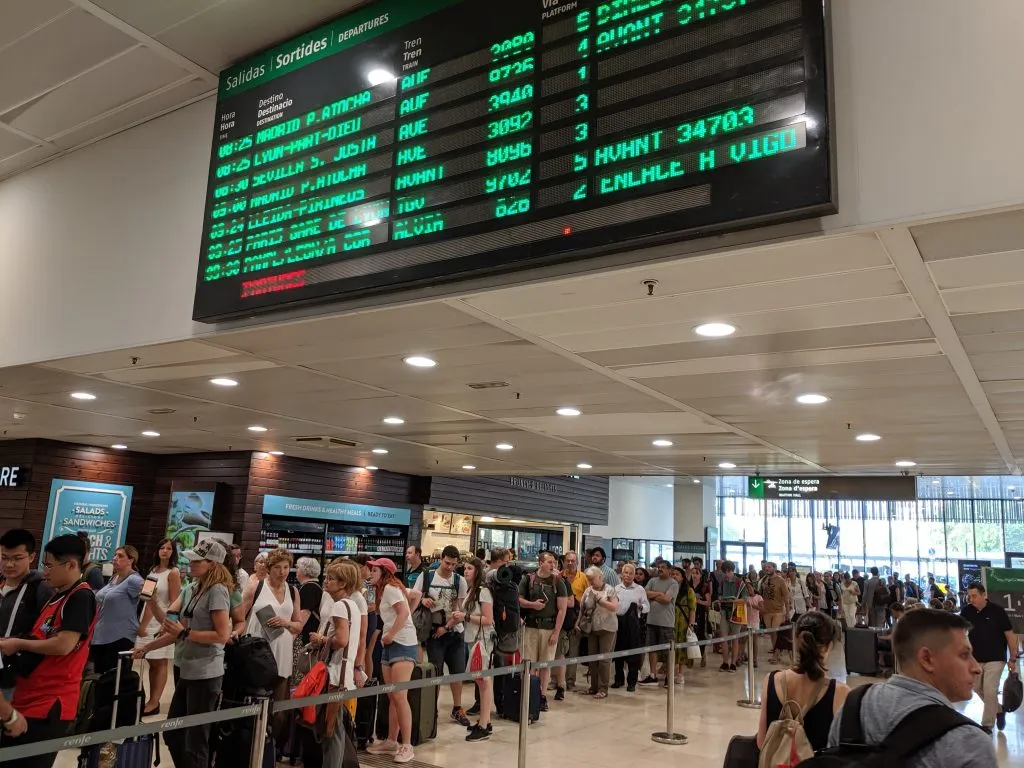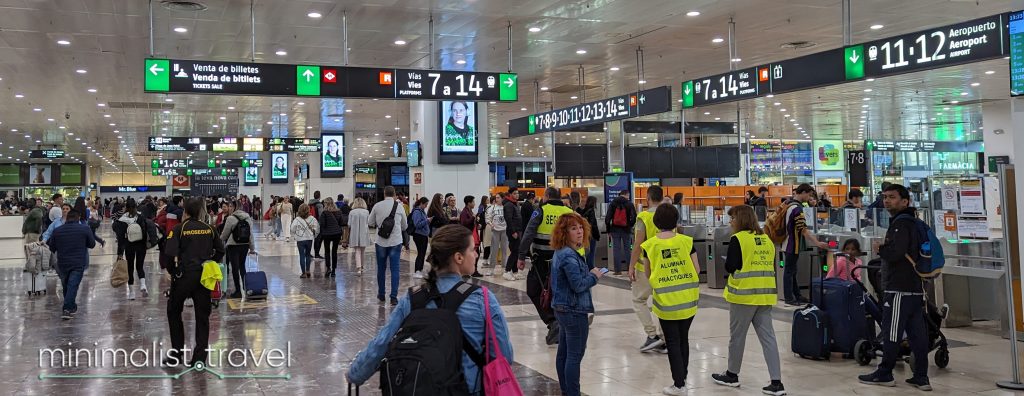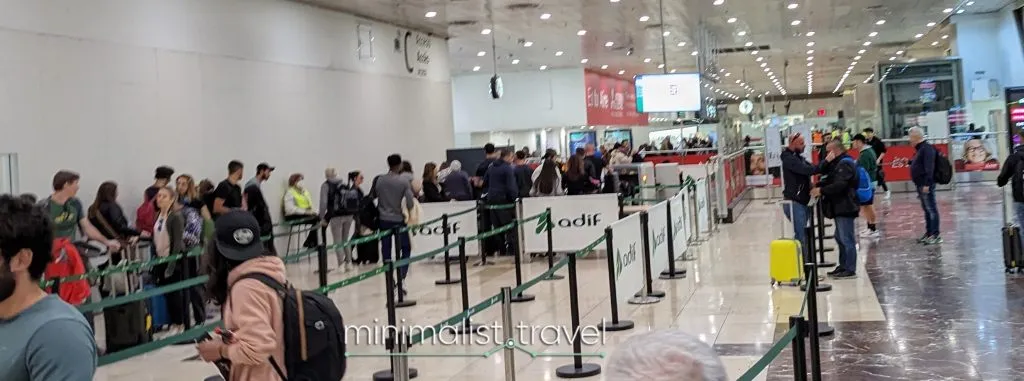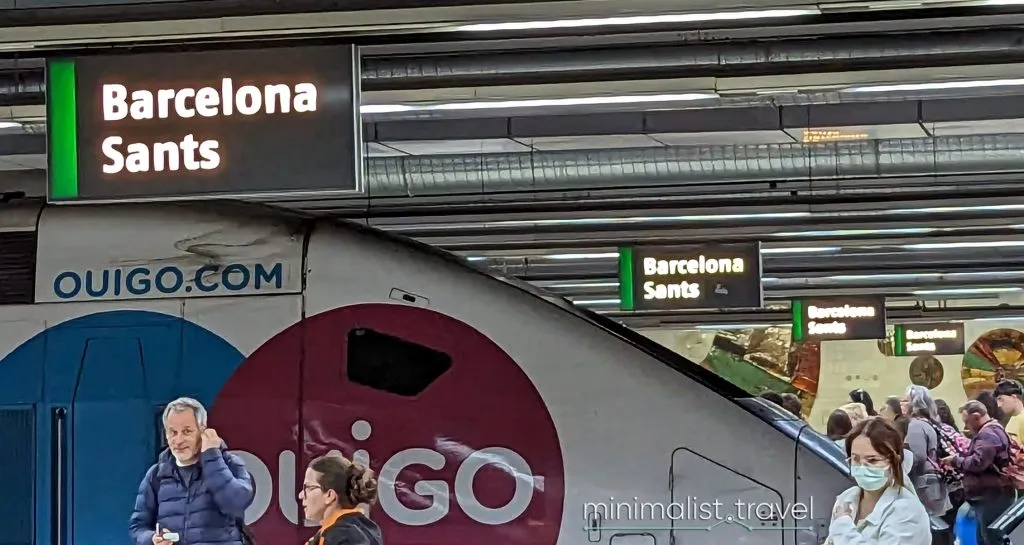
Barcelona Sants Station is unlovely but clean and well equipped with a range of services. It’s not huge, but can seem a bit bewildering to newbies.
So let me be your guide. I’ve lived next to the station for 15 years, I go in every day to catch the metro, and at weekends I regularly take the local trains to get around Catalonia, and sometimes far beyond. I know the station’s charms and annoyances, and I’d like to share a few tips and tricks for making it a more pleasant and efficient experience.
Barcelona Sants: Key Facts before You Go

- The main station in Barcelona is officially called “Barcelona Sants”. Locals refer to it as “Estació de Sants”, “Sants Estació” or just “Sants”.
- The station has medium and long distance trains (including fast trains) going to various points in Spain and France. These trains are run by Renfe (the national Spanish operator) as well as competing budget high speed brands: Ouigo, Iryo, and (Renfe’s own) Avlo.
- There are also commuter trains run by Renfe known as Rodalies (Catalan) or Cercanias (Spanish).
- The metro stop connected to Barcelona Sants is called “Sants Estació”.
- When making your way to your train, the display boards and entrance gates are different for the local and longer distance trains. So pay attention to whether you are traveling on Rodalies or one of the longer distance options from Renfe and the always long distance budget trains Ouigo, Iryo, or Avlo.
- The station is located at Plaça dels Països Catalans, 1, 7, 08014 Barcelona.
- It is open Monday to Friday 04:15 – 00:30 and weekends and public holidays 05:00 – 00:30.
The Renfe website lists ten stations for Barcelona. Some of these are in far-flung neighbourhoods and you are unlikely to come across them as a traveller.
Barcelona Sants is the main hub for commuter, national and international trains. Barcelona Estació de França also has some national as well as commuter trains, and commuter trains you may use also leave from the smaller underground Barcelona train stations Plaça de Catalunya, Passeig de Gràcia, and Arc de Troimf. Note that “Barcelona Sants”, “Barcelona Sant Andreu” and “Barcelona Sant Andreu Arenal” are three separate stations.
Buying Train Tickets for Trips to/from Barcelona Sants Station
Where and how to buy tickets depends greatly on whether you are traveling in the greater Barcelona area or further afield.
Tickets for Medium and Long Distance Travel
Whether you’re traveling from Barcelona to Zaragoza, Madrid, or elsewhere in Spain, remember that there are now a variety of competing operators; this means that prices can be quite good.
Some of the best deals can only be found online and cannot actually be purchased in Barcelona Sants itself.

The quick way to find the best deal for your particular route is by booking online on Trainline. It compares all of the operators that serve Barcelona Sants at once, so you quickly find out if Renfe, Iryo, or Ouigo is cheapest for your particular trip. And in our tests of the best ways to get Spanish train tickets, Trainline consistently came up with the smarter, cheaper routes on trips with changes than Renfe’s site.
Another good website that also offers all competing rail services but in addition includes flight options is Omio.
While we’ve ridden and written up a comparison all of the train operators serving Sants, we tend to just choose whichever Trainline shows as having the best price. But it is also possible to buy from each operator individually:
- Spanish national operator Renfe has regional and medium distance (media distancia) trains called Avant, Regional, Regional Exprés, MD or Proximidad. These tickets are sold in Barcelona Sants at ticket windows 1 to 5 (hours: 06:00 – 22:00). They are also available via Trainline mentioned above and can be bought in advance via Renfe’s sometimes aggravating, dysfunctional website: Renfe.com (partially translated in English). There’s also a phone line for sales: +34 912 320 320.
- Renfe’s long distance (larga distancia) trains are called Intercity, Alvia, Altaria or Euromed and their high speed trains are Ave, AV City or Avlo. We’ve previously written about the experiences riding Ave and the budget Avlo trains; they’re both quite pleasant. Tickets for these can also be purchased easily via Trainline or for the adventurous via Renfe’s site and phone mentioned in the previous point. In Barcelona Sants, the long distance and high speed trains are sold at ticket windows 8 to 21 (hours: 06:00 – 22:00). Although there are a lot of ticket windows, many will be unstaffed and there are often long waits. Staff can be unhelpful, may not tell you about ways to save money, and may not speak much English. They offer Renfe tickets only, and not the competing Iryo and Ouigo options.
- The private operator Iryo offers a nice and just slightly upscale high-speed experience to get from Barcelona Sants to Zaragoza and Madrid, as well as further afield in Spain. Tickets can be bought in advance via Trainline or Iryo’s website as well as from the Iryo point in the station (see map).
- French operator Ouigo runs goofy-looking pink-and-blue budget trains from Sants to Tarragona, Zaragoza, and Madrid; we’ve also enjoyed the Ouigo experience. Ouigo tickets are not available at Barcelona Sants or any physical sales point; they must be purchased online via Trainline or Ouigo’s Spanish site.
Tickets for these trains are often cheaper in advance and can be sold out on the day, so make sure to book as early as possible to get the best fares.
Tickets for Commuter / Suburban Trains (Rodalies de Catalunya)
- These tickets can only be bought in the station on the day of travel.
- Tickets can be bought:
- At the orange-coloured ticket machines.
- At windows 1-5 from 06:00 to 22:00. And as mentioned above, the staff can be rather unhelpful in our experiences (even if you speak flawless Spanish and Catalan) and not speak a lot of English.
- Tickets are valid for two hours from the moment of purchase.
- Note that you can travel to any station within Zone 1 of this map (including the airport TRAIN station) with a standard Zone 1 metro ticket.
- Trains for the local FGC (Ferrocarrils, the Catalonia commuter service) do not depart from Sants Station. See the map of FGC alongside other local services.

Key Vocabulary and Pronunciation in Sants
This article prioritises the Catalan names for buildings and streets, as they are the names you are most likely to encounter, especially on posted signs.
- This main station in Barcelona is officially called “Barcelona Sants”. Most locals will refer to it as “Estació de Sants”, “Sants Estació” or just “Sants”.
- The metro stop connected to Barcelona Sants is called “Sants Estació”.
- Renfe (Red Nacional de los Ferrocarriles Españoles) “ren-FAY”: Spain’s national passenger railway company
- Estació / estación “es-tas-ee-OH” / “es-tath-ee-ON”: Station (Catalan / Spanish)
- Via “VEE-ah”: Track
- Anden “an-DEN”: Platform
- Rodalies / Cercanías “ro-dah-LEE-as” / “ther-ca-NEE-as”: Suburban or commuter trains (Catalan / Spanish)
If you’re ready to get a bit more advanced, we have articles on toasting in Catalan, flirting in Catalan, speaking to inanimate objects in Catalan, and, most vitally, Catalan pooping. We also have covered sexy Spanish.
Finding Departure / Arrival Information—Check the Right Displays!

Various screens showing departure and arrival information can be found around the station. “Departures” is “Sortides” or “Salidas”, “Arrivals” is “Arribades” or “Llegadas”.
Times for different types of trains are shown on different screens, so don’t panic if you can’t see your train on the first screen you look at. First locate the screen for the type of service (long-distance or local, arrivals or departures) you want, and then look for your train time and number.
For commuter / suburban trains, the most comprehensive departure list can be found above the long line of orange-coloured ticket machines next to the exit gates from platforms 7-14.
If the commuter train to Sitges, for example, is due at 14:17 but is delayed by 3 minutes, it will be displayed as “Sitges 14:20” rather than “Sitges 14:17, 3 minute delay”. Similarly, if a train is cancelled, it will just disappear from the screens, the cancellation will not be announced.
The platform (via) for commuter trains is often not announced until the last minute. You will often see the airport train announced as “Aeroport. Via 11-12”. This means the train will arrive at either platform 11 or platform 12.
When catching commuter trains, you’ll find it helpful to know which line you are catching (R1, R2, R3, etc) as some screens only show the information by line.
Making Your Way to Your Platform
Commuter / Suburban trains

- Commuter trains leave from platforms 7 to 14.
- The platform for commuter trains is often not announced until the last minute. You will often see, for example, the airport train announced as “Aeroport. Via 11-12”. This means the train will arrive at either platform 11 or platform 12. Platforms 11 and 12 are next to each other, so you can still head down to wait. You will then need to keep your eyes and ears open for the platform announcement, which may come only moments before the train arrives.
- It’s a good idea to check with another passenger that you’re getting on the right train, as last-minute alterations are not uncommon.
- For baggage limits on commuter trains in Catalonia, the rule of thumb is that your baggage should not inconvenience other passengers. Baggage is not inspected, but there is a limit per item of 20 kg (110 lbs) and 70 x 50 x 25 cm (27.6 x 19.7 x 9.8 in). Nobody actually weighs or measures your bags on these local trains, though presumably this could happen if you’re obviously transporting an unusual amount of stuff. More detail is available at the Rodalies de Catalunya baggage policy in section 7.

Medium Distance, Long Distance, and High Speed (Ave, Avant, Avlo, Iryo, Ouigo…) Trains


- The medium and long distance trains, whether Renfe or competitors Iryo and Ouigo, leave from platforms 1-6.
- There is no formal check in, but arrive at least 30 minutes before the scheduled departure time as you need to go through a baggage screening. The lines for baggage screening may be long but they move quickly as they are nowhere near as thorough as the process for airports (you do not need to take out liquids and laptops, nor take off your shoes).
- The train doors close 2 minutes before departure.
- Make sure to check the company’s baggage policy; we’ve got more info on the high speed services’ policies for Ave, Avlo, Ouigo, and Iryo. Ave and Iryo allow you to carry larger pieces without paying extra and are unlikely to measure your luggage carefully in Barcelona Sants unless it’s clearly excessive; Ouigo and Avlo are more likely to enforce to their tight limits.
Getting to and from Sants Station
Metro and Local Bus
Two metro lines pass through Sants Station, Line 3 (green) and Line 5 (blue). The Google Maps app is your best bet for understanding how to get anywhere within Barcelona on public transport, but this map of the metro service is also helpful, as is their metro info. Here is the bus map and info.


The map below shows the bus and metro stops near Sants (in the middle).

Taxis
Taxis can be found outside both entrances to the station. There is often a long queue on the Plaça dels Països Catalans side, and fewer people waiting on the Plaça de Joan Peiró side (the west side). Note that public transport is excellent in Barcelona (cheap, reliable, frequent and clean, although sometimes crowded) and can be a faster option than waiting for a taxi.
Bus Station

There is a small, ugly bus station behind Sants Station, with limited services to national and international destinations. This is not the city’s main bus station so many services do not stop here. You are more likely to use the Barcelona Nord Bus Station, for example.
We have a full article on the many available bus companies covering Europe and how to get cheap bus tickets. But in a nutshell, to leave Barcelona by bus cheaply, run searches on Trainline and BusBud.
Car Hire
There are a number of car hire companies located in or around Sants Station. They are listed here in order of distance from the station.
Inside the station SABA car park on floor -1 (Plaça dels Països Catalans, 08014 Barcelona):
On top of the station (Plaça dels Països Catalans, 08014 Barcelona):
Plaça de Joan Peiró, 08014 Barcelona:
Carrer de Viriat, 43, 08014 Barcelona:
Carrer de Viriat, 45, 08014 Barcelona:
Carrer del Rector Triadó, 104, 08014 Barcelona:
Carrer de Dolors Batlle i Sunyer, 17, 08014 Barcelona:
Indigo Car Park, Carrer de Numància, 33, 08029 Barcelona:
C/ de Numància, 39, 08029 Barcelona:
Calle del Rosellón, 9, 08029 Barcelona:
Parking
- Before planning on driving to Sants Station, it is worth noting that the station falls within the Low Emissions Zone (LEZ). This means that only certain types of vehicles can drive in this area from Monday to Friday, between 07:00 and 20:00.
- Check here to see if your vehicle can enter the LEZ.
- Vehicles with foreign number plates must register before entering the LEZ.
Sants Station Car Park
- The official Sants Station car park is located underneath the station.
- Open 24 hours a day.
- Spaces for disabled users are available.
- Up-to-date price information can be found here.
- Maximum height allowed: 2.1 metres.
- VIA T available (entry and exit).
- Reserve a space in advance.
Other Car Parks Nearby
A quick Google will show several websites that allow you to reserve nearby parking spaces in advance, some of which include a free transfer from the car park to the station.
Bike Parking
- There is currently no secure bike parking at the station.
- There are spaces to leave your bike outside the station. This site’s editor has parked cheap bicycles with expensive U-locks overnight on the streets near the station and never been robbed. An expensive bike, no matter how good the lock, would likely be stolen.
- The shared city bikes in red docks near Sants are part of a system called Smou (formerly Bicing) that is not made available to visitors; you must be a resident with a local address and fiscal number to sign up.

Barcelona Airport Connections with Sants Station
If you are travelling to/from Terminal 2, the airport train is great. It’s spacious, clean, fast and cheap. However, if you are travelling to Terminal 1, or not starting very close to Sants Station, you may find the Aerobus more convenient. We do not recommend travelling from the Sants area to the airport by metro, as it is much slower and involves at least one change of line.
- The train between the airport and Sants Station runs approximately every half hour and takes around 18 minutes. Here are the timetables.
- You can travel between the airport and Sants Station:
- With a standard Zone 1 metro ticket (available at any metro station).
- With an individual ticket bought:
- (In Sants Station) at the orange-coloured ticket machines.
- (In Sants Station) at windows 1-5 from 06:00 to 22:00 (not recommended due to queues).
- (At the airport) at any ticket machine.
- These tickets can only be bought on the day of travel and are valid for two hours from the moment of purchase.
Travelling from the Airport to Sants Station
- The train station is located in Terminal 2. If you arrive in Terminal 1, catch the free airport shuttle to Terminal 2. This journey takes 14 minutes and is not possible on foot. Then walk along an unglamorous sky bridge to reach the station. Make sure you head into the Rodalies station on the right-hand side, and not the metro, which is located next to it.
- All trains departing from the airport stop at Sants Station.
Travelling from Sants Station to the airport
- The airport is on the R2 Nord line (note that there is also a line called “R2 Sud” that does not go to the airport).
- At the time of writing, the airport train usually leaves from platform 11 or 12. The platform is often not announced until the last minute. You will often see the airport train announced as “Aeroport. Platform 11-12”. This means the train will arrive at either platform 11 or platform 12. Platforms 11 and 12 are next to each other, so you can still head down to wait for the train. You will then need to keep your eyes and ears open for the platform announcement, which may come only moments before the train arrives. The train will have the destination “Aeroport” as a sign on every carriage. However, it’s still a good idea to check with another passenger that you’re getting on the right train, as last-minute alterations are not uncommon.
- When you arrive at the airport you will walk through the sky bridge into Terminal 2 and then catch the free airport shuttle to Terminal 1 if necessary (14 minutes, not possible on foot).
Travellers with Disabilities or Reduced Mobility
Barcelona Sants Station is well adapted for travellers with reduced mobility or other disabilities.
Accessible Features of Sants Station
- The main concourse, including all entrances, shops and bars is step-free.
- Tactile pathways (limited).
- Lifts to platforms.
- Tactile platform edges.
- Accessible toilets (three locations, priced 1 Euro).
- Parking spaces.
- Induction loops at some ticket offices (indicated).
- Note 1: the ticket machines have braille signs, but are not actually accessible for the visually impaired.
- Note 2: whilst the metro station Sants Estació is accessible, the elevators are not located within the station and you will need to travel a short distance outside the station and across a couple of roads to reach them so make sure you leave a little extra time. You will need the entrance “Pl. Països Catalans / Nùmancia / Ambulatori”. Further information can be found here.

Assistance Available
Assistance services for travellers with limited mobility include:
- Wheelchair users can receive help to get around the station and on/off the train.
- People with mobility difficulties who do not have their own wheelchairs can be leant a wheelchair and receive help to get around the station and on/off the train.
- Visually impaired people can be accompanied around the station and receive help to get on/off the train and find their seat.
- People with learning or comprehension difficulties can receive guidance and be helped through the station to their seat on the train.
Requesting Assistance
- Whilst you do not need to pre-book assistance, you need to request help 30 minutes before your train departs. To do this, head to the Acerca office next to the ticket windows.
- To save time and stress on the day of travel and to ensure your needs will be met (in case of staff shortages, queues, etc), we recommend calling the assistance service as far in advance as possible (+34 91 214 05 05). After booking the service, you will receive an SMS two days before your date of travel, reminding you of your request and of the meeting point.
- Renfe has released the Assistance Service app. It can be used to request help, but many reviews say that, as with other Renfe apps, it often doesn’t work.
- When requesting assistance:
- Communicate whether you will be travelling with a companion or carer, or with a guide dog / assistance dog.
- If you are using your own wheelchair, you’ll be asked if you wish to be seated in a separate seat. In this case, the wheelchair must be closeable/foldable.
- You’ll be asked if you require a wheelchair within the station.
- You’ll be asked if you need assistance boarding or disembarking the train.
- If you are hard of hearing, you’ll be asked if you have a hearing aid or other device to aid communication.
- People with visual impairments can sign up for the “Linea 900” service to book / change / cancel a Renfe ticket or request help by calling +34 900 400 555 (free). To sign up for this service, you must fill in a form and attach a document certifying your disability.
- Requests for assistance for international trips within Europe should be made at least 48 hours in advance, by emailing [email protected] or by calling +34 917 744 040 (06:00 – 00:00).
For more on assistance services for disabilities, see these pages for Renfe, Ouigo, and Iryo.
Booking an Accessible Seat on a Train
- Wheelchair users booking a ticket for a Renfe mid-/long-distance or AVE train will need to select the option “Trains with accessible wheelchair space” if using the Renfe site.
- You must then request the assistance service in advance (see) to ensure that ramps are put in place for the trains. You must do this even if you do not usually need any help as unfortunately, merely requesting a wheelchair-accessible space is not sufficient.

Station Map and Facilities at Sants Station
Adif, which runs Barcelona Sants, does not publish an official up-to-date map of the Station on its sites. We found various maps of the station floating around on the internet but they were all out-of-date with info that is now incorrect. We have reached out to Adif and asked for a better map; we’ll update this if they ever offer one.
We did find a map for the main level posted in the train station that was correct and took a picture of it, below.

The keys to note:
- You enter the station from Plaça de Joan Peiró on the left or Plaça dels Països Catalans on the right, or else from the metro at the top.
- Access (via down escalators and elevators) to tracks 1-6 for high speed trains is on the left side in dark grey and is labeled A, B, and C.
- Access (via down escalators and elevators) to tracks 7-14 for the regional and local trains is on the bottom right.
- Ticketing windows are in the bottom middle left.
- This map is highly simplified. Not pictured: All of the stores, cafés, people, and chaos.
Information and Customer Service

Don’t expect northern European or North American types of service. Be prepared for long waits, rudeness, a lack of information, little desire to help and a low level of English.
- Iryo: customer service and ticketing at the Iryo point in the middle of the station
- Renfe (“Atenció al client” / “Atención al cliente”): the customer service center near access point C
- Rodalies (Cercanias) info: to the right of the ENTRANCE gates to the Rodalies trains
- Ouigo does not have a customer service point in Sants
Left Luggage (Storage)
- The left luggage facility (“consigna”) is one floor below the car park. It is run by The Excess Baggage Company. It is open from 05:30 to 23:00. It is a “manned” service, meaning you hand your bags over to a person and they do the rest for you. There are no lockers within the station. If you are using this service, be sure to leave yourself enough time to queue for your bags before your train leaves. Here is information about prices and bag sizes.
- Lockers can be found nearby.
Lost Property Office
Property Lost at the Station or on Renfe, Ouigo or Iryo trains

Items lost at Sants station or on any non-commuter train boarded / disembarked at Sants will be held in the lost property office (“Objectes perduts” / “Objetos Perdidos”).
- Monday – Friday 09:00 – 13:30 / 16:30 – 19:00. Closed on weekends.
- Located at the centre of the station.
- Call +34 934 956 020 for lost property, or + 34 912 320 320 for customer service.
- Items will be kept for “for 15 days and 2 months” (no, I don’t know what this means!)
- You will need to prove that the item was yours (for example, showing your train ticket, providing the PIN number of a mobile phone or describing the contents of a bag).
- You may have to pay related expenses in order to have the item returned.
Property Lost on Trains to Portugal (Lusitania / Surex / Tren Celta)
- Call +351 218 545 212.
Property Lost on Rodalies / Cercanías (Commuter) Trains
- Property left on these trains is unlikely to be held at Sants. To enquire about lost items, either complete this form (in Catalan, or its translated version) or call +34 900 410 041.
Tourist Information
- A small tourist information office is located in the centre of the station, behind the ticket windows for long-distance trains.
- Monday to Friday 8:30 – 20:30 (Saturdays and Sundays until 20:00).
Police
- A small Mossos d’Esquadra (Catalan police) office is located to the left of the metro entrances.
- Reports can be filed there for theft and other crimes. It is open from Monday to Friday 07:00 – 23:00, Saturday and Sunday 09:00 – 21:00.
Toilets
- 3 locations within the station (one of which is behind ticket barriers for the high speed trains and is free—you’ve already paid for your ticket at that point—the others cost €1).
- All locations contain accessible toilets.
- Open from 06:00 to 00:00.
The toilets that you have to pay for are run by 100 Restrooms:
- These are next to the boarding area for the high-speed trains.
- The price of these restrooms (€1) can be redeemed as a discount at certain participating bars/cafés and shops within the station).
- Services include a beauty bar, a water station, a disabled room, a family room, a breastfeeding area, a health-check area, and “motivational mirrors” with hygiene tips.
- These restrooms also contain a shower room (06:30 – 21:30, priced €5 for 20 minutes).

Foreign Currency Exchange
- There is a currency exchange office (website in Spanish only) in Sants located next to an entrance on the Plaça dels Països Catalans side.
- It is open Monday to Saturday 07:00 – 22:00 and Sundays 08:00 – 21:00.
ATMs
ATMs for various banks are located near to both entrances on the Plaça dels Països Catalans side.
Pharmacy
- There is a large (by Catalan standards) pharmacy located next to the Plaça dels Països Catalans entrance.
- Monday to Friday 06:30 – 22:30, Saturday and Sunday 08:00 – 22:30.
Tobacco and Stamps
- Cigarettes and other smoking-related products, as well as postage stamps, can be purchased at “Tabacs” outside the Plaça dels Països Catalans entrance (no access from within the station).
- Everyday 06:00 – 21:45.
WiFi
The only free WiFi available at the station is at (and near to) the McDonald’s café; WiFi is also available for premium Renfe passengers in the Sala Club Lounge.
The high speed trains from Iryo, Ouigo, and Renfe have WiFi but the service is intermittent and slow.
Food Recommendations in and around Sants Station

There are a few cafés and bakeries within the station. Offerings are somewhat uninspiring and overpriced, and there aren’t many options for those with dietary restrictions. But at the very least, there is more variety and fresher food than what you find served in the long distance trains themselves; you may want to pick up a sandwich before your trip if you have time. Alcoholic drinks can be purchased in some of the establishments.


If you have slightly more time, there is a Mercadona supermarket close by (closed Sundays and public holidays).
Or head to Passeig de Sant Antoni where you’ll find a selection of reasonably-priced tapas bars, fast-food outlets and Middle Eastern restaurants (recommended).
Meeting Point in Barcelona Sants
While it is not an official meeting point, the easiest place to find people and be found is in front of the McDonald’s. Unlike other cafés or information desks, there is only one McDonald’s in the station. And it is easily found by anyone as there are various signs around the station advertising it and pointing to its location.
The “food” offerings, obviously, should not actually be consumed for health and ecological reasons.

Premium Lounge (Sala Club)
- Open to Renfe passengers with “Premium” or “Luxury tourist train” tickets.
- Open daily from 05:20 to 21:30 (from 06.30 on Sundays).
- Available 2 hours before train departure.
- Services include WiFi, snacks, drinks, toilets.
- Located opposite the McDonald’s seating area.
Shopping
There are a few small and unexciting gift, fashion, cosmetics, book and food shops, but keep your expectations low.
A Park and a Plaza just outside the Station
- Head to the nearby Parc de l’Espanya Industrial, a park where there is always a lot going on (Bolivian dance practice, rap battles, multiple sports, sunbathers by the lake, children having the time of their lives on a dragon slide, and more).
- Watch the skaters in the exceptionally ugly Plaça dels Països Catalans.

Hotels on top of and next to Sants
There are a lot of hotels close to the station that will suit most budgets listed in Booking.com. Some of the closest are:
- Barceló Sants (4-star, right on top of the station).
- Cosmo Suite Penthouse (3-star apartments).
- Hotel Transit (1-star).
- Meeting Point Hostels (dormitory accommodation).
Sleeping in Barcelona Sants
There is nowhere to sleep inside the Barcelona Sants station and it is locked at night.
Safety
- Sants Station does not have the dangerous feeling that accompanies some major stations in Southern Europe. It is busy at all hours of the day and there is often an armed police presence outside.
- Rough sleepers are often found outside the station at night, but they don’t tend to interact with travellers.
You should still take the same precautions against pick-pockets and petty crime that you would in the rest of the city.

Bon Voyage and Send Updates!
We frequently update our articles based on input from readers, so let us know about your experiences, ask questions, and tell us what has been useful in the comment section below. We appreciate it!








As an American traveling to Spain for the 20th time. Your information was very valuable.
Thank You.
Thank you, thank you, thank you! We are traveling to Spain next spring. No car, so it’s trains for us, and at 62 with minimal Spanish, we are likely to get a bit confused if we don’t have plenty of information ahead of time. This is going to help so much!